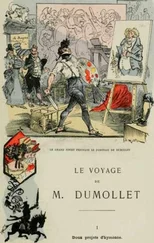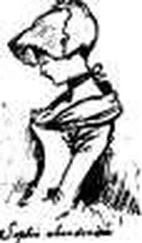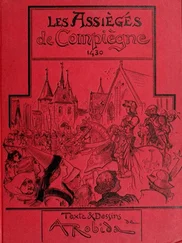Albert Robida - Yester-year; ten centuries of toilette from the French of A. Robida
Здесь есть возможность читать онлайн «Albert Robida - Yester-year; ten centuries of toilette from the French of A. Robida» весь текст электронной книги совершенно бесплатно (целиком полную версию без сокращений). В некоторых случаях можно слушать аудио, скачать через торрент в формате fb2 и присутствует краткое содержание. Жанр: Старинная литература, на английском языке. Описание произведения, (предисловие) а так же отзывы посетителей доступны на портале библиотеки ЛибКат.
- Название:Yester-year; ten centuries of toilette from the French of A. Robida
- Автор:
- Жанр:
- Год:неизвестен
- ISBN:нет данных
- Рейтинг книги:4 / 5. Голосов: 1
-
Избранное:Добавить в избранное
- Отзывы:
-
Ваша оценка:
- 80
- 1
- 2
- 3
- 4
- 5
Yester-year; ten centuries of toilette from the French of A. Robida: краткое содержание, описание и аннотация
Предлагаем к чтению аннотацию, описание, краткое содержание или предисловие (зависит от того, что написал сам автор книги «Yester-year; ten centuries of toilette from the French of A. Robida»). Если вы не нашли необходимую информацию о книге — напишите в комментариях, мы постараемся отыскать её.
Yester-year; ten centuries of toilette from the French of A. Robida — читать онлайн бесплатно полную книгу (весь текст) целиком
Ниже представлен текст книги, разбитый по страницам. Система сохранения места последней прочитанной страницы, позволяет с удобством читать онлайн бесплатно книгу «Yester-year; ten centuries of toilette from the French of A. Robida», без необходимости каждый раз заново искать на чём Вы остановились. Поставьте закладку, и сможете в любой момент перейти на страницу, на которой закончили чтение.
Интервал:
Закладка:
The little seed of folly which always lurks in the frivolous and topsy-turvy brain of the goddess of fashion, was about to sprout. While still retaining the beautiful and becoming Pompadour and Watteau forms for a while, the mode was preparing to work its wild will upon head-dresses, to take women's heads for the parade-ground of its maddest whims, to
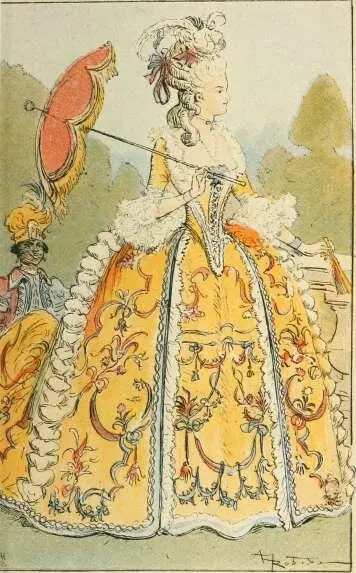
GRANDS PAXIHRS LOUIS XVI.
load them with the most absurd inventions imder the pretext of beautifying them, to transform them into landscapes, or indeed into sea-pieces, then to befeather the latter, raise them up to a fabulous height, and erect edifices upon them, with little cardboard figures of men and women to complete the absurdity.
Then would Paris swarm with hair-dressers of genius, the Legros and the Leonards, the Raphaels and the Rubenses, or rather the Soufflots of the barber's art, and these personages would set up academies for teaching the principles of their capillary architecture ; striving who should attain the utmost perfection of the ridiculous in the adornment of aristocratic heads, and all succeeding pretty equally in reaching it.
The wigmakers had already had their day of glory and renown in the great century, that of the majestic peruke ; having now become academicians of hair-dressing, they were about to secure a fresh triumph, at the expense of feminine grace.
Let us observe the lady of the period at lier toilette, preparing to make her calls, or to go to the Tuileries at the fashionable hour. This laboratory business, for so it must be reckoned, is the impoitant affair of the day, it means the adjustment of mere beauty to the prevalent taste. The toilette hour, after the ' petit lever,' has been delineated by Lancret, Baudoin, and the other gallant or elegant painters of the age, with all the skill that they possessed, and the caricaturists have not refrained from depicting it either.
Madame, seated before her mirror—its frame is carved and gilded—in the dressing-closet with its white Avood panels, moulded and carved in the style called ' rock-work,' has been dressed by her women ; at her ' petit lever ' she has given audience to her admirers and her milliners, to the marquis and the banker, to the poet who extols her charms in the Almanadi des Muscs, to the flippant ' chevalier,' and the gallant Court Abbé.
" What does the Abbé say ? " The Abbé is a person of taste, and his opinion upon everything connected with the freaks of fashion is valuable.
But all these frivolous people have been dismissed, it is the hair-dresser's hour, the serious, the only really important moment of the day.
The artist needs to be alone, lest his inspiration should be put to flight, and besides, the task is long, difficult, and requires much care and preparation to render it successful. He can tolerate one or two waiting-women who understand him at half a word, and hand him everything he requires while he is in the fine frenzy of composition, but no other spectator.
According to the rank of the lady, this hairdresser will be the great artist, who comes in his coach, passing swiftly from hôtel to hotel in the noble Faubourg, and expected at the Tuileries, or by some princess, or else he will be one of the great artist's pupils, operating in a dress-coat, with lace ruffles and a sword by his side.
The inspiration comes, and under the fingers, the comb, and the curling-tongs of the artist an extraordinary structure of natural curls, skilfully mingled with enormous quantities of borrowed hair, is built up in stages, on which are piled bows, ' frizzes,' ' gates,' ' chestnuts,' 'crutches,' &c., for these extraordinary names were given to the inventions of the hair-dressers.
For twenty years this medley of strange constructions under pretence of hair-dressing went on. Folly had taken up its abode on the heads of women. Among the most preposterous inventions, I may enumerate the * Quèsaco/ the ' Monte-au-ciel ' (the name indicates its proportions), the ' Comète,' the ' Hérisson à quatre boucles ' (or ' Hedgehog with four curls,' invented by Marie Antoinette, who outdid the exaggeration of fashion), the 'Parterre galant.' Then we have the Cradle of Love and the Novice of Venus, as names for hats of outrageous size and shape.
Poufs were bewildering things ; the ' pouf au sentiment ' was an absurd arrangement of
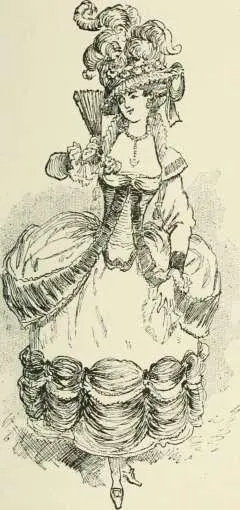
A courtesan, after Wille.
flowers and shrubs, witlv birds in the branches, growing on a high hill of hair ; butterflies and Cupids flew about this garden. There were
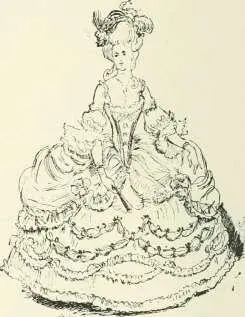
Court dress.
also the ' pouf à la chanceliere,' or foot-muff pouf, the 'pouf à droite,' and the 'pouf à gauche.'
The ' pouf au sentiment ' allowed great latitude to invention, and the display of feeling and taste. The Duchesse de Chartres, mother of King Louis-Philippe, wore on her pouf a miniature museum of little images, her eldest son in his nurse's arms, a little negro, a parrot nibbling a clierry, and designs executed in the hair of her nearest and dearest kinsfolk.
After the ' garden ' hair-dressing, we find the ' Cascade of Saint-Cloud ' style, consisting of a cataract of powdered ringlets falling from the top of the head, the ' kitchen-garden ' style, with bunches of vegetables hooked in to the side-curls, the ' rural ' style, with landscapes representing a hill-side, windmills which actually turned, a meadow crossed by a silver stream, with a shepherdess tending her sheep, mountains, a forest with a sportsman and his dog in pursuit of game, &c., &c.
Then came the ' Coliseum,' the ' Innocence,' the 'Peal of bells,' the 'Bobwig,' the 'Milkmaid,' the ' Bather,' the ' Kerchief,' the ' Neckerchief,' the ' Oriental,' the ' Circassian,' the ' Minerva's helmet,' the ' Crescent,' the
' Bandeau of Love,' and among hats, the ' Enigma,' the ' Desire to please,' the ' Tiirned-up Calash,' the 'Pilgrim Venus/^ the 'Treasurer of the age,' ' Frivolous Bather/ &c., while hair-curling was done in ' sustained sentiments/ or ' sentiments recalled.'
The full-dress head-gear, a great scafFolding bedecked with feathers and flowers in tufts and garlands, was so large and so heavy, and took up so much space, that ladies, who already found it difficult to get their paniers into their cai'-riages, had to hold their heads down on one side, or even to kneel on the floor of the vehicle.^
Caricatures of the period represent ladies wearing these monstrous head-dresses in Sedan chairs, with the roof taken off to allow the top of the gigantic structure, powdered to an Alpine whiteness, to come through.
The most amazing of all these inventions was the ' Belle-Poule,' so called in honour of
1 Pilgrim Venus apparently means Venus with her cockle-shell, an antique design.
2 See note, Appendix, p. 263.

PARISIENNES 17S9.
the victory of the frigate La Belle Poule over The Arethusa, an English ship, in 1778. Upon the great mass of hair arranged in rolling waves, was placed a frigate in full sail, witli
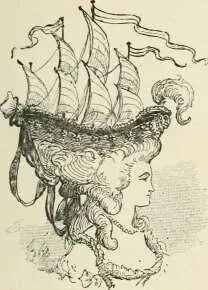
Head-dress à la Belle Poule.
all its masts, yards, guns, and little sailors. After having composed such a master-piece, Léonard or Da<���ïé micjht g;o hano- themselves, they could never beat that.
Читать дальшеИнтервал:
Закладка:
Похожие книги на «Yester-year; ten centuries of toilette from the French of A. Robida»
Представляем Вашему вниманию похожие книги на «Yester-year; ten centuries of toilette from the French of A. Robida» списком для выбора. Мы отобрали схожую по названию и смыслу литературу в надежде предоставить читателям больше вариантов отыскать новые, интересные, ещё непрочитанные произведения.
Обсуждение, отзывы о книге «Yester-year; ten centuries of toilette from the French of A. Robida» и просто собственные мнения читателей. Оставьте ваши комментарии, напишите, что Вы думаете о произведении, его смысле или главных героях. Укажите что конкретно понравилось, а что нет, и почему Вы так считаете.

